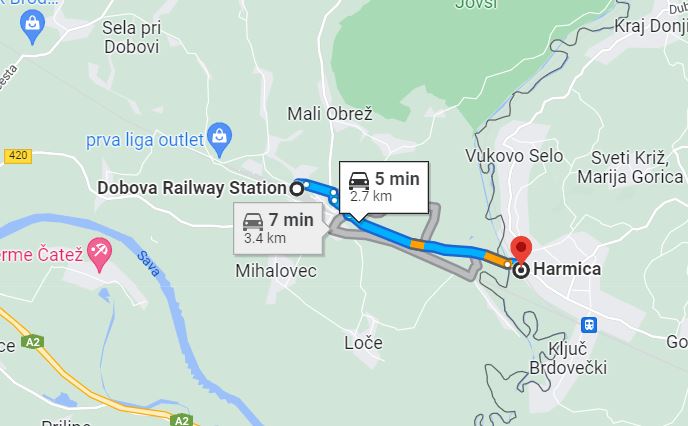Croatian Railways: Three New Trains Released for Traffic
December 22, 2022 - Croatian Railways: three electric trains for urban and suburban transport produced in Končar were put into traffic today, after which a contract for the purchase and sale of battery trains and stable energy connections was signed.
As Index writes, the new trains are part of the rolling stock renewal project of Croatian Railways Passenger Transport (HŽ PP), which is implemented in accordance with the Transport Development Strategy of the Republic of Croatia from 2017 to 2030, is co-financed from the Operational Program Competitiveness and Cohesion 2014-2020, and is part of the National Recovery and Resilience Plan 2021 - 2026 (NPOO).
The trains were produced by Končar.
The total estimated value of the project is HRK 1.3 billion, and the support from the European Union is HRK 880.3 million. HŽ PP plans to modernise the rolling stock with 21 new electric trains as part of this project. Eleven trains are planned for urban and suburban transport and ten for regional transportation.
The trains were manufactured by Končar, one of which had its ceremonial first run from Zagreb's central station to Dugo Selo and back. After today's release of the first three trains for urban and suburban transport, eight more trains will be delivered to run in the Zagreb area.
The delivery of regional trains, which will run on electrified tracks in Croatia, will follow after that. Deputy Prime Minister and Minister of the Sea, Transport, and Infrastructure Oleg Butković said at the release that the renovation of the railway infrastructure is a key project that will mark the next 10 to 12 years.
The plan is to introduce 70 new trains into traffic by 2025
"Such a project follows a natural course, and it is good that the procurement of 21 new trains is financed with the help of European funds, and this is only the first delivery of trains," said Butković. He added that all funds available from the EU and national and credit funds will primarily be directed to renovating the railway infrastructure and purchasing new trains.
The plan is to introduce 70 new trains into traffic by 2025, said Butković. The president of Končar electric vehicles, Josip Ninić, noted that the key subsystems of the new trains were developed and produced in the companies of the Končar group, and numerous other local companies were also involved.
As part of the "Application of green technologies in railway passenger transport" project, a contract for purchasing and selling battery trains and stable energy connections was also signed on Wednesday.
HRK 100 million has been secured from NPOO for the purchase of new battery electric motor and battery trains and six stable and energy connections that will be installed at the stations of Split, Osijek, Varaždin, Bjelovar, Virovitica, Pula, and the total value of the project is HRK 129 million.
The aim is to improve local and regional connectivity and mobility for better access to the labour market and services in functional centres and to ensure more efficient and competitive passenger transport, say HŽ PP.
For more, make sure to check out our dedicated Travel section.
Croatian Trains Made You Late? Here's How to Get Compensation
October the 22nd, 2022 - Have you been made more than an hour late getting into work because of Croatian trains arriving late? You could be entitled to compensation from HZ. Here's how you can get your hands on it.
As Poslovni Dnevnik writes, owing to maintenance works being carried out at this moment in time on the railway section from Okucani to Strizivojna, Croatian trains running along it are unfortunately being delayed by up to 50 minutes at a time. As a result, passengers are also being made late for work, school or scheduled medical appointments. Such people can count on a payout for their lost time.
Croatian trains are often late and therefore so are their passengers. At the station in Slavonski Brod, Marica was waiting for a passenger to arrive from Novska, so far, that passenger is about 20 minutes late, but last time, she explained, it was like this: "They announced that the train would be half an hour late, then it was 60 minutes, then 50 minutes, then 70, in the end it was 60,'' explained Marica from Zadubravlje.
There are still irritated and anxious passengers boarding Croatian trains, but also those who are already for issues to arise and those who are more than used to delays. "It causes issues throughout the day for everything for me when this happens, it's a disaster. This has been going on for some time now, too,'' stated another annoyed passenger, refering to an accident in Novska which be believed caused additional stress and problems.
HZ Infrastruktura (Infrastructure) has denied this. Croatian trains are late, they note, due to the maintenance of the railway infrastructure on the Okucani-Sibinj and Strizivojna-Slavonski Brod sections.
"The accident that happened recently happened between Novska and Okucani. We're working to exclude construction work and that has nothing to do with signalling," said Darko Barisic, a member of the HZ Infrastructure Management Board, on October the 6th, 2022. While the aforementioned works are in progress, Croatian trains will continue to run more slowly and be delayed by around fifty minutes at a time.
Everything should be finished at the beginning of next month, and passengers were asked if they think HZ should compensate them for lost time.
“Well yes, they should. People are being made late for work, what can people do about that?'' they commented.
"HZ Infrastructure must do its work and there will be no compensation", is the message of Darko Barisic, but that isn't quite the case. There is compensation of sorts to be had, but only if the train is delayed for more than an hour.
For a delay of 60 to 119 minutes, compensation is paid in the amount of 25 percent of the ticket price. For delays longer than 120 minutes, compensation is paid in the amount of 50 percent of the ticket price. Along with the request to exercise this right, it is necessary to attach a certified ticket and send everything by post, email or hand it over at the cash desk.
For more, make sure to keep up with our dedicated news section.
Battery Electric Trains to Run Along Croatian Railway Lines
September the 6th, 2022 - Croatian railway lines aren't exactly the subject of many words of praise. In fact, the entire train network and system requires an overhaul of epic proportions and pales horribly in comparison to the rest of the country's public transport offer, which in most respects is very good. Battery electric trains are apparently set to take to Croatian railway lines in the future.
As Poslovni Dnevnik/Darko Bicak writes, although the Republic of Croatia actually does have an extensive network of railways, 635 kilometres per million inhabitants to be more precise, the network is outdated with non-standardised parameters, that is, it only has a small number of kilometres of double-track and electrified railways, and according to many indicators, Croatian railway lines are at the very back of the EU in terms of service efficiency.
With that being said, large investments in Croatian railway lines, trains and overall infrastructure should soon change that, and on that track, the HZ Passenger transport (Putnicki prijevoz) tender has just been announced for the procurement of two battery electric train prototypes and six connections for charging those drive batteries along the country's railway network.
As explained from HZ Passenger transport, the company currently organises Croatia's train network with 60 diesel engine trains that are older than 40 years and whose service life is rapidly running out.
When taking into account this obsolescence and generally large financial investments in an additional electrification system, a logical way thinking and a solution to the current situation is offered by introducing battery electric trains. In this case, this would mean the acquisition of two new train prototypes and the delivery and commissioning of six stable energy connections for charging the drive batteries at locations in Varazdin, Bjelovar, Virovitica, Osijek, Split and Pula.
The battery electric train (BEMV) has a battery that is charged at the terminals, but also along the electrified part of the track as it runs along it, and they would be used on mixed tracks for the destinations Zagreb - Varazdin, Bjelovar, Virovitica and Osijek.
On the other hand, the battery motor train (BMV) is charged only at stable energy connections and would be used along mostly non-electrified tracks on the routes from Zagreb to Split and Pula. The deadline for the delivery of these battery trains to HZ Passenger transport is 20 months from the signing of the contract.
For more, make sure to check out our dedicated travel section.
Another Delay From Zagreb-Split Train: "Sorry, We'll Refund 50%"
August the 1st, 2022 - Croatia isn't known for its high speed, uber efficient train network. In fact, it's quite the opposite, and it doesn't really seem as if anyone quite knows what to do about it. A Zagreb-Split train was recently delayed, one of many of late, by 134 minutes in total.
We've recently had stories about a train driver simply deciding not to turn up to work, leaving passengers waiting around for far longer than they should have, and one about an employee falling asleep on the job, causing issues for yet another train. Will it ever get better, you might ask?
As Morski writes, the Zagreb-Split train carrying passengers was due to arrive in the Dalmatian port city on Friday at 15:20, but instead, it arrived 134 minutes late. Croatian Railways (HZ), who have been having to do an awful lot of explaining lately, says that the problems started when the train's air conditioner malfunctioned at 16:10 at the train station in Karlovac.
''Given that the bus operator couldn't provide the three buses needed to transport the passengers sitting on train 523 within 60 minutes, a second unit was sent from Zagreb Central Station, which left Karlovac station 92 minutes late, and then arrived at the Split train station with a 134 minute delay,'' they stated from Croatian Railways.
The train which has ended up being faced with issues and delays is otherwise a recently introduced line that runs from Osijek to Split, and it is, it seems, very regularly late.
Croatian Railways will refund all passengers 50% of their purchased ticket price.
Croatian Railways apologised to the passengers on the Zagreb-Split train and told them that they are free to exercise their right to compensation for the delay.
In case the train is delayed from 60 to 119 minutes, compensation is paid in the amount of 25% of the original ticket price. And if, as is the situation in this case, the delay is longer than 120 minutes, compensation is paid in the amount of 50% of the ticket price, as reported by Index.
For more, make sure to check out our dedicated lifestyle section.
29-Hour Train Ride from Split to Rijeka? Yet Another Shocking Croatian Railways Journey
July 23, 2022 - Ever wondered about the train ride from Split to Rijeka? A look at the travel options between Croatia's second and third largest cities.
Croatia is a tourist country, where around 20 percent of the national budget depends on income from tourism. Despite this, the traffic connection between Split and Rijeka, the second and third largest cities in the Republic of Croatia on the coast of the Adriatic Sea, is very poor.
Foreign tourists or Croatian citizens who want to travel from Split to Rijeka during the summer have limited options.
The first option is, of course, traveling by car. For those who do not go to the sea by car, there is only one more option: the bus. The fastest bus ride from Split to Rijeka takes about seven hours. You don't go on the highway, which would take 2-3 hours less, but it would cost more because of tolls.
So, what about the train? A search on the Croatian Railways website shows that the train journey from Split to Rijeka takes between 22 and 29 hours, with a minimum of one transfer. Allow us to repeat - if you want to travel by train from the second largest Croatian city to the third largest Croatian city, it can take more than a day - 29 hours, writes Index.hr.
For comparison, a trip on the Trans-Siberian Railway from Moscow to Vladivostok takes six days, covering 9,289 kilometers. Split is slightly more than 400 kilometers from Rijeka, or 416 kilometers, according to Google Maps. A Trans-Siberian Railway train covers about 64 kilometers in one hour, while a Croatian Railways train covers an average of about 14 kilometers in one hour on a full-day journey from Split to Rijeka. No wonder it takes a whole day if you decide to travel from Split to Rijeka by train.
Regarding air transport, there is no direct route from Split to Rijeka. It was operated by Trade Air, but the Ministry of Transport did not extend its contract in time. As a result, they stopped flying on the Split - Rijeka route at the end of April this year.
The official Trade Air website states that they hope to connect Split and Rijeka (as well as Osijek and Pula, etc.) by air again from August 15 of this year.
It is also worth noting that the Split - Rijeka flight is a PSO line. PSO stands for Public Service Obligation. This program enables countries within the European Union to co-finance airlines for flights that are not always directly commercially profitable but are of public importance.
And what about by sea? There is no longer a night ferry line that connects Split and Rijeka, on which the famous Marko Polo ferry used to travel. The Jadrolinija Rijeka - Dubrovnik line was discontinued in 2015.
Index asked Jadrolinija why:
"The decision to cancel the Rijeka - Dubrovnik line was first made in 2012 by the then Government due to the constant decline in passenger and vehicle traffic, which was caused by the construction of highways to the south, which made vehicle journeys to destinations in Dalmatia significantly shorter, so the line recorded fewer passengers. In 2015, the line was discontinued," Jadrolinija said.
However, it seems that this could change.
"Given all the circumstances and the development of highways, cooperation with the Maritime Faculty on a study on redefining the line is underway. Jadrolinija primarily maintains state lines connecting the islands with the mainland, and currently, there is no Rijeka - Split line maintained by Jadrolinija," Jadrolinija revealed.
"Croatia, as a tourist destination, is well connected to the most important markets, both by road and by air, i.e., airlines, and there are also shipping lines as a link by sea," says HTZ.
They also add that this is one of the essential prerequisites for attracting foreign guests, whose pleasant and quality stay requires a good transport infrastructure and connections within the destination, that is, the country where they are staying. The above applies to domestic tourists as well.
"Namely, with the quality transport connections of Croatian cities, we can further encourage our guests to discover other destinations and increase tourist consumption," says HTZ.
For more, make sure to check out our dedicated travel section.
Jon Worth EU Cross Border Rail Project Comes to Croatia: Oh Dear!
July 13, 2022 - Croatian railways made be old and underfunded but that is - it seems - only half the story, as TCN learned in a fascinating two hours with leading Green blogger Jon Worth on his fascinating (and slightly geeky) EU Cross Border Rail Project.
One of my favourite things about my 'job' is the random nature of my inbox. Once I sift through the constant abuse from my trolls, there are always a couple of very random and intriguing invitations and leads. Croatia is such a fascinating country and so few people write about it in English that I invariably get selected by default.
Incoming email from a friend, one of my very favourite people in Zagreb a few weeks ago:
hello there
long time no see (or hear), hope to grab a beer at some point in the near future?
to make a long story short: a friend of mine Jon Worth is doing this crazy project of trying to cross every single railway border crossing in europe
here is the project web site: https://crossborderrail.trainsforeurope.eu/
he will be passing through zagreb in early july (only couple of hours will be in zagreb) and I was wondering if wanted to join us for a beer near the railway station
fun fact (actually, not funny at all); slowest stretch of rail travel during his 40 days of trail traveling will be in croatia
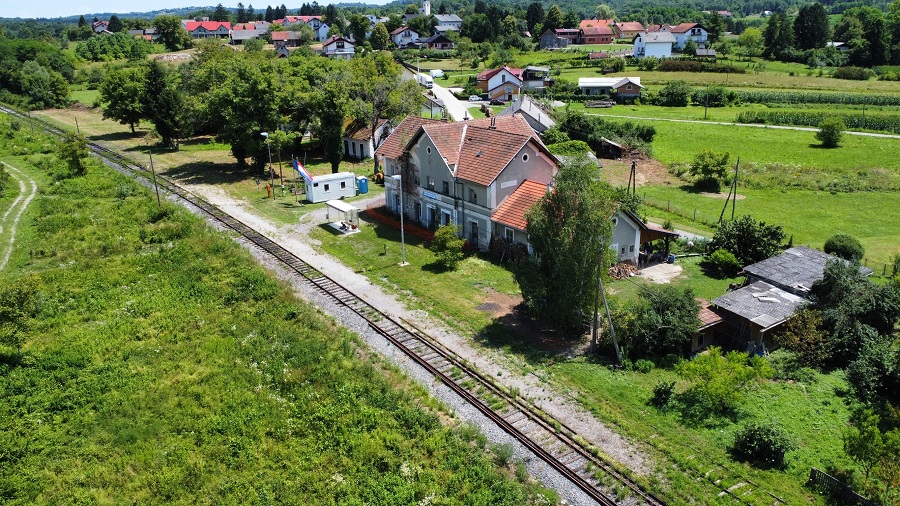
Although train geeks are not really my thing, my Croatian friend has a fine understanding of the art of the absurd, and so I knew there would be more to this than advertised. The promise of free beer sealed it, then I promptly forgot about the whole thing until my friend sent me a reminder a few days ago. Just what was this project, and who was this guy?
It turns out it sounded rather interesting indeed.
A chap with his own Wiki page, this Jon Worth was a political blogger, journalist and editor who regularly writes about EU policy, Brexit and Germany policy. Since 2015 he has been a visiting professor at the College of Europe. His Euroblog ranked the third most influential left-of-center blog in 2010 by Social Europe. And he seemed to be rather passionate about train travel and improving cross-border train travel and developing a digital European rail timetable in particular.
His visit to Croatia was Day 25 of a 40-day, publicly crowdfunded project inspired by an initiative by the Chairman on the Transport Committee of the European Parliament:
Back in 2015, the then chair of the Transport Committee in the European Parliament, Michael Cramer examined 15 so-called “missing links” – places where trains used to cross borders within the European Union, but no longer do.
7 years on I wondered: what has come of those missing cross-border rail links Cramer had proposed to fix when he was a MEP?
So the idea was born to plan a huge rail and bike journey that crosses every internal border inside the European Union (and EFTA countries) that you can cross by train. And en route stop for at least long enough to organise a meeting in the political capital of each country to discuss these issues with local activists,
My instructions from my friend were to meet him on Platform 2 of Zagreb Train Station at 18:27 to await the arriving train from Karlovac, which threw me into some confusion, as I could not work out what border was being crossed or where Worth was coming from.
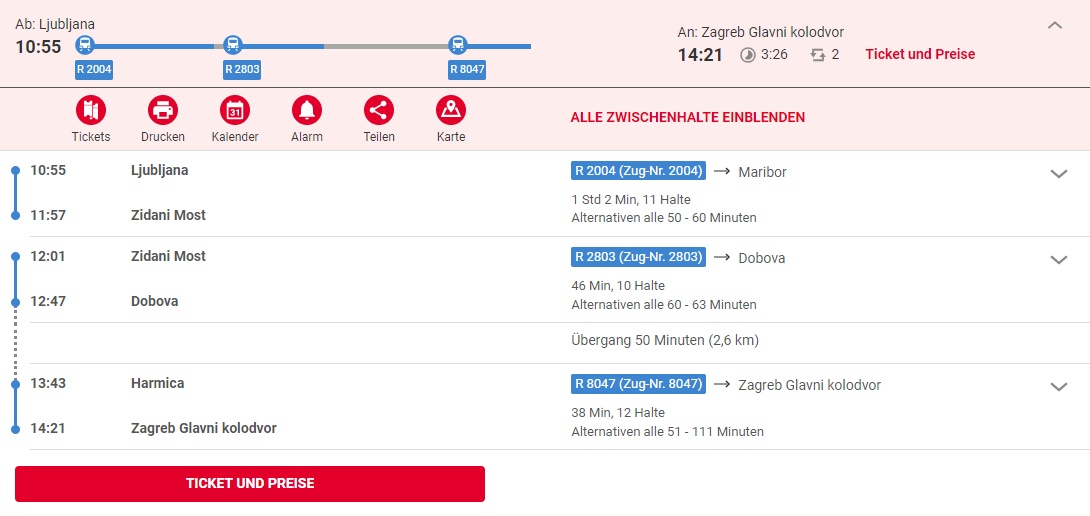
As often happens these days, the day before we were due to meet, the inbox gifted me another gift, this time from a Swiss friend who was planning a train trip from Ljubljana to Zagreb, only to find he would have to WALK 2.7 km between the two countries if he wanted his preferred travel time.
Ljubljana to Zagreb, once an internal connection in the former Yugoslavia, today a journey between two countries, with a Schengen border in between. It is my understanding that this walk is not necessary on the majority of the connections between the two, but it does apparently exist. And things will hopefully improve as the Schengen border moves to the east of Croatia.
And so to Platform 2 of Zagreb Train Station, where my friend greeted me cheerfully with the surprising news that the Croatian train was late. We caught up until, some 30 minutes later, the Karlovac train pulled into Platform 4, and Jon Worth emerged, complete with trusty fold-up bike to fill us in on his adventures so far.

He had started his day in Ljubljana and decided to enter Croatia via Novo Mesto and Metlika towards Karlovac via Bubnjarci, before heading to Zagreb for meetings and dinner and then the overnight train through Slovenia to Munich.
As not all the routes in the project are functional, Worth is also travelling with a foldup bike to cover border crossings, and his day included a 38-kilometre cycle to Karlovac from the border.
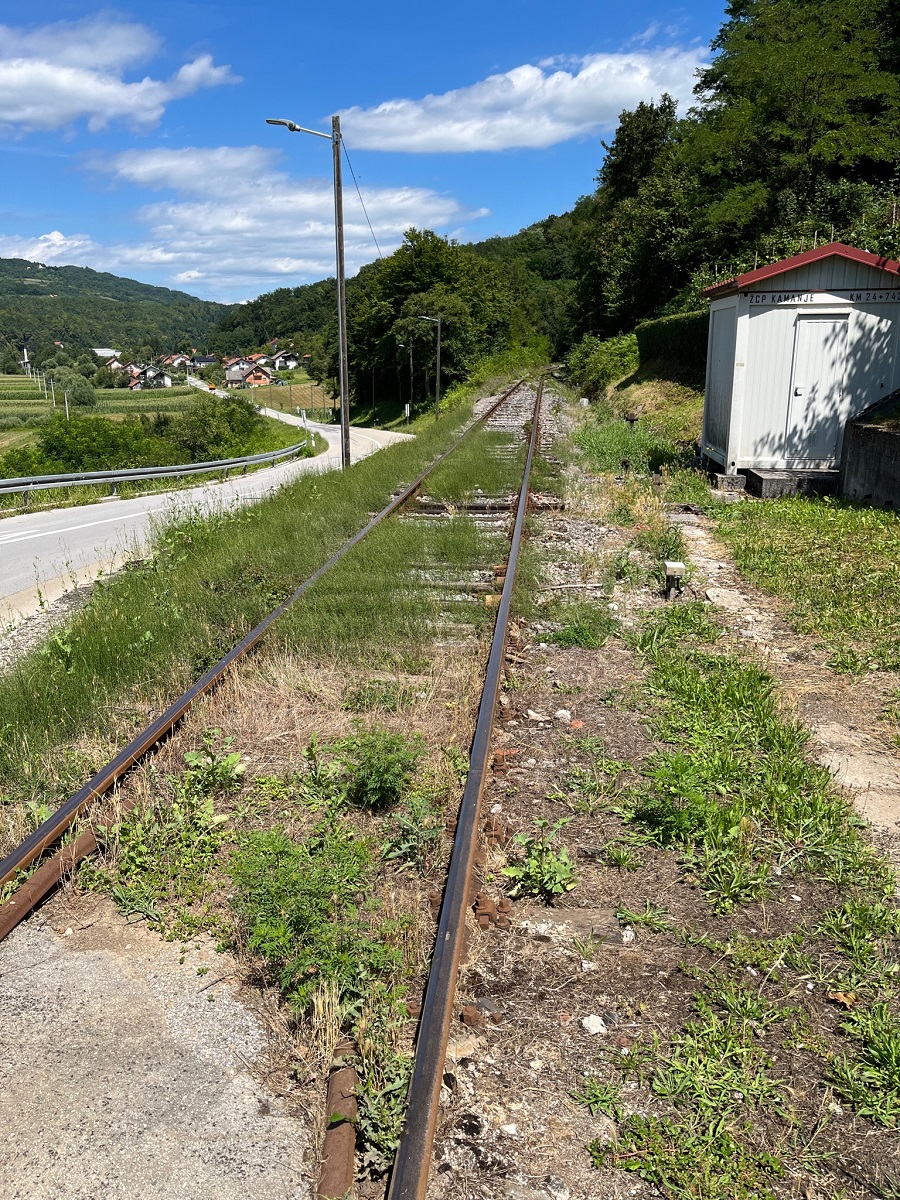
No train has run between Croatia and Slovenia since COVID, as the weeds suggest, and while there is a service part of the year from Bubnarcji during the year, it does not operate in the summer.
Bubnarcji station itself is a sad shadow of its former self, where chickens roam the platforms where once cross-border passengers did.
"In fact, the railway in Bubnjarci is perhaps the worst I've seen so far, covered in oil, and the bridge it crosses is physically blocked by something, I guess to prevent migrants from crossing. That's why I cycled here all the way to Karlovac," said Worth.

Worth knew that he would not be taking the train on the Croatian side due to the timetable, which saved Croatia from an ignominious award of the slowest track on the entire project across each EU border - just 28.23 km/h. Unconfirmed eyewitness accounts claim that Worth cycled to Karlovac quicker. The second slowest was in Romania at 33 km/h.
What really interested me about meeting Worth, however, was not so much the underinvestment in Croatian railways - it is hardly news (and as long as we have pearls like the recently-launched Osijek to Split train service which takes 13 hours - at least officially, the first one was over 80 minutes late), but the total lack of coordination between national railways to improve information and cross-border travel. The raging success of the privately-owned Regiojet trains from Central Europe to Croatia's Adriatic coast has shown that there is huge potential in increasing and developing cross-border rail travel.

But one of the key issues is a very basic one which really should not be an issue in this digital age - lack of information.
One of Worth's aims is to have a digital rail timetable for Europe and a Skyscanner-type website service for buying rail tickets. It seems an achievable goal. I actually thought something like this existed with the www.bahn.de website, but that excellent German resource is actually quite incomplete when it comes to national timetables. A Worth blog earlier this year gives an outstanding example of how Croatia's already terrible rail network is actually portrayed to be even worse than it is - bringing additional frustrations to passengers. The case of the cross-border service from Osijek to Pecs in Hungary illustrates the point perfectly.
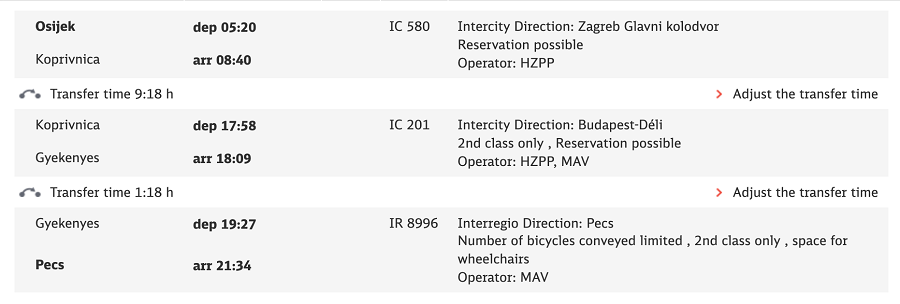
When Worth wrote his blog earlier this year, he found only one train a day between Osijek and Pecs, a distance of 90 km and 1 hour 20 by car.
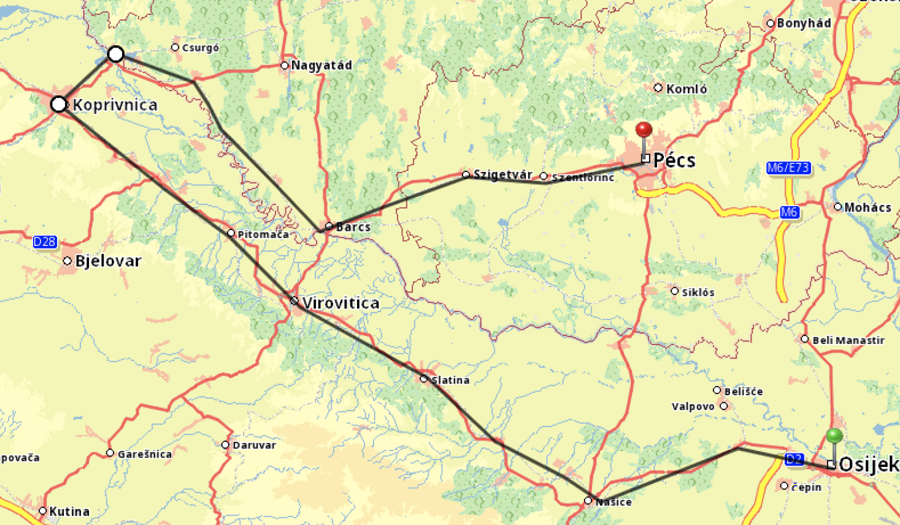
The train journey took an exceptional SIXTEEN hours and 14 minutes, with a 10-hour layover in Koprivnica.
And yet, there is a functioning rail track between the two countries.
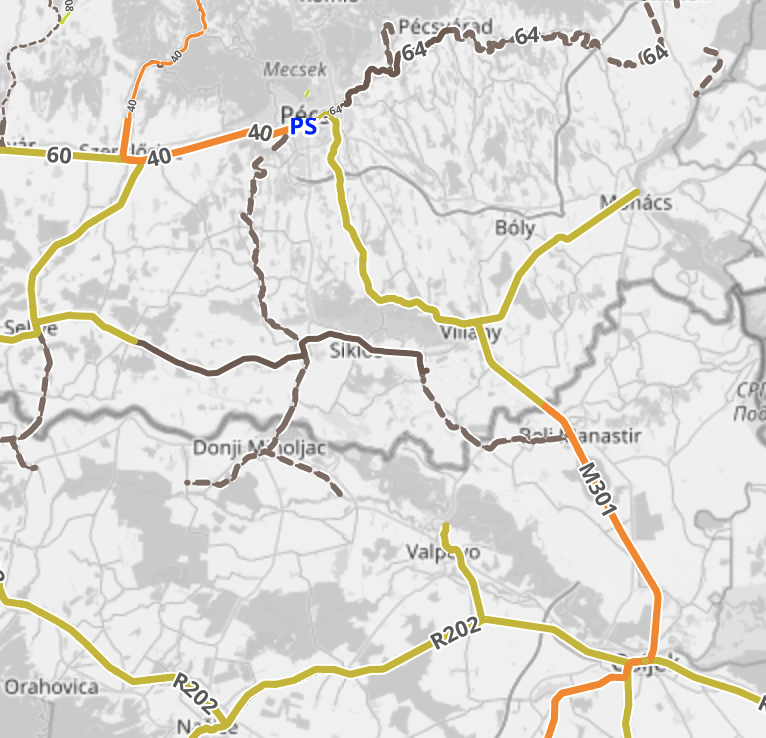
And, on the Bahn.de timetable, there is also a cross-border train to Beli Manistir in Baranja from Pecs.

And not just one, but several a day between Baranja and southern Hungary. Given that there is rail track between Osijek and Beli Manistir, there must be a train, surely, thought Worth?
And indeed there is. Several.
He decided to check the Croatian Railways website, and here is what he found.

A wonderful selection, many of which connected conveniently for onward travel to Hungary. As Worth noted:
There would be a safe connection departing Osijek at 10:11, arriving Beli Manastir 10:41. Depart Beli Manastir at 11:43 and arrive Pécs at 13:07. Trip time: 2 hours 54 minutes (versus 16 hours 54 minutes proposed by DB!) and 1 change (better than the 2 with DB).
So an efficient train route exists but nobody knows about it, so nobody uses it. How is such a thing possible, we wondered.
Worth explained that sites like Bahn.de have the international network but they are reliant on getting data for national timetables from a (from memory) French body which coordinates with national railways to provide that information. If the national timetable is provided, as it is in Hungary, then all local trains are included in the Bahn.de timetable. If, in the case of Croatia, they are not, then they are necessarily excluded, and passengers are left with the only online solution of a day out in Koprivnica.
But here's the thing that floored me.
"But 20 years ago," explained Worth as he sipped his beer, "Croatian national timetables were included and so the information could be found online in the integrated European timetable. Indeed, this was the case until about 5 years ago."
It seems that someone from Croatian Railways stopped sending the information to the French.
So there we go. If you want to have some low-hanging fruit success at improving the efficiency of Croatian railways, it seems that all is needed is to get some chap to export an Excel spreadsheet to the responsible French organisation to add to the European database. And in one email, we could reduce journey times from 16 hours to under three. And THAT would surely place Croatia as the EU champions of improved rail performance.
#CrossBorderRail summary Day 25 https://t.co/dK0kEwhgUY
— Jon Worth (@jonworth) July 11, 2022
I leave the final word to Jon Worth himself, who uploaded his observations by video on Twitter:
And perhaps the final, final word of this quite magnificent poster at Zagreb station, seemingly warning people to be aware of the oncoming speedy train. I can't think of a more fitting symbol of the state of Croatia's railways.

Now will someone please send that email to France, please?
You can follow Jon Worth's EU Cross Border Rail Project here.
Croatian Railways: Seventy Brand New Trains Due Before Year 2024
June the 30th, 2022 - Croatian railways aren't usually praised by many users of their services, with complaints about the trains being slow frequent and even situations in which the train drivers not bothering to turn up for work occurring. Could all that change with some new acquisitions?
There is an enormous amount to see all over this extremely geographically diverse country, which, while small, packs a punch from the sparkling Adriatic Sea and its impressive rugged coastline to its imposing, karst mountain ranges, luscious green rolling hills, picturesque lakes and seemingly endless Eastern vineyards. Seeing it all by train would be the preferred choice of many if things ran a little more smoothly, and it seems like that's going to happen.
As Poslovni Dnevnik writes, recently, the Minister of Maritime Affairs, Transport and Infrastructure, Oleg Butkovic, visited the Koncar factory hall in which brand new electric trains are being produced as part of the project entitled The Reconstruction of the Croatian Railways (HZ) Passenger Transport fleet.
The new trains are being co-financed from the Competitiveness and Cohesion Operational Programme 2014-2020 in the amount of 85 percent, and the total estimated value of the project stands at a whopping 1.29 billion kuna.
Croatian Railways is continuing modernising its entire fleet with eleven brand new electric trains for urban-suburban transport and ten other new electric trains for regional transport, and by the year 2024, it should have almost seventy new trains in use across the country, which makes up more than fifty percent of the current fleet.
These brand new and much more modern trains set to take to Croatian railways will reach a speed of 160 kilometres per hour and will be equipped with ramps for people in wheelchairs, and there will also be proper bicycle space and free internet access for passengers.
For more, make sure to check out our dedicated business section.
HŽ Zagreb-Pula Train Needs 22 Hours and 43 Minutes to Travel 267 km?
My 23, 2022 - Croatian train travel has never been applauded for its efficiency, especially when one HŽ Zagreb-Pula train needs almost 23 hours to travel 267 kilometers.
A screenshot from the official Croatian Railways (HŽ) website has recently been spread on social networks, showing just how long it will take HŽ passengers to travel from the central railway station in Zagreb to Pula, reports Index.hr.
The distance from the central railway station in Zagreb to Pula, according to Google Maps, is 267 kilometers.
Since HŽ does not have direct trains on the Zagreb-Pula route, the official HŽ Passenger Transport website offers several travel options - one with three transfers and one option with two transfers.
The shortest HŽ ride from Zagreb to Pula takes just under 9 hours
If you take Croatian Railways to get from Zagreb to Pula today, however, you will ride for at least 8 hours and 48 minutes. According to the schedule, the train departs at 1:12 pm and will arrive in Pula at 10 pm after two transfers. The price for one passenger in one direction is 73 kuna and 10 lipa.
The longest ride takes an incredible 22 hours and 43 minutes
However, if you decide to leave about an hour later, or at 2:22 pm, you will arrive in Pula only tomorrow after 22 hours and 43 minutes of traveling and three transfers.
The travel length, in other terms, is not much better: Only two options offer a travel length of fewer than 9 hours, and there are travel options that take 12 hours and 15 minutes, 19 hours and 45 minutes, 18 hours and 33 minutes, and 15 hours and 19 minutes.
Now, anyone choosing to drive this 267 km route can make it from Zagreb to Pula in just over 3 hours. Croatia Airlines even has non-stop and connecting flights from Zagreb to Pula that'll get you there even quicker (though at a much higher price).
Those of us in Croatia already know that Croatian Railways is unlikely anyone's go-to for traveling around Croatia, especially with so many bus options and the Bla Bla ride-sharing evolution. And if you need further proof of Croatian travel failures - just check out this two-day Slavonian train adventure traveling just 83 km away!
For more, check out our travel section.
10 Years Ago HZ Ordered New Trains for €1.66 Billion, Where Are They?
April the 17th, 2022 - A decade ago, HZ (Croatian railways) purchased 44 new trains for the mind-boggling price of 1.66 billion kuna, but where are they today?
As Poslovni Dnevnik/Jadranka Dozan writes, in order to procure seven new diesel-electric motor trains, the Croatian Government gave the "green light" to HZ Putnicki prijevoz (CR Passenger transport) to sign pre-financing and lease agreements with EUROFIMA - the European Society for Financing the Procurement of Railway Materials. The value of this financing stands at a massive 31 million euros.
When it comes to the renewal of HZ Putnicki prijevoz's fleet, ten years ago, as part of the strategic goals of restructuring, the government "appointed" a plan worth 1.66 billion kuna for the purchase of a total of 44 new passenger trains - 32 being electric and 12 being diesel-electric.
A few years later (more precisely back in 2014), sales were agreed with Koncar - HZ PP Electric Vehicles, and in the same year financing was provided for a total of 33 such trains.
A total of 29 electric trains have been delivered so far, and the remaining three deliveries are expected to arrive later this year. In the case of diesel-electrics, all five had financing provided for them (one loan from HBOR, and four from an IBRD loan).
For the remaining seven vehicles, funding is being provided through EUROFIME, with delivery being promised by the end of 2024, thus completing the major procurement project.
In addition to approving these requests from HZ Putnicki prijevoz, in order to finance the reconstruction and modernisation of Croatian railway infrastructure on projects not financed from European Union (EU) funds and international development banks, the Croatian Government also approved a request from HZ Infrastruktura (Infrastructure) for two loans from HBOR in the amount of 200 million kuna.
These are loans envisaged by the Financing Plan for the year 2022 and projections for the coming years of 2023 and 2024. The explanation states, among other things, that the debt balance of Infrastruktura for total credit loans at the end of January amounts to 1.78 billion kuna.
For more, make sure to check out our business section.
Direct Railway Line Between Bjelovar and Split Will Start this Summer
January 14, 2022 - The Bjelovar-Bilogora County has managed to reach an agreement with HŽPP, and Bjelovar will be connected to the Adriatic by a direct railway line for the first time from July 1st, this year.
The seasonal tourist train will run once a day on the route Osijek-Virovitica-Bjelovar-Zagreb-Split, reports HrTurizam.
It will depart from Osijek at 8 pm, in Bjelovar at 11.35 pm, and at its final destination in Split it should arrive at 8.42 am. Return from Split is planned every day at 22.06 hours, the train would arrive in Bjelovar at 8.11 hours, and in Osijek at 11.36 hours. The line will run until August 27.
"The direct railway line that will connect Bjelovar to the Adriatic for the first time is the result of our efforts and talks we started last autumn. We are extremely pleased with the agreement reached with HŽPP and consider it important progress in connecting Bjelovar with other parts of Croatia," said the prefect Marko Marušić, who talked with the representatives of HŽPP about the better connection of Bjelovar with Zagreb and the possibility of introducing a student train from Bjelovar to Zagreb.
Namely, children and students of primary and secondary schools will be able to travel for free, in accordance with the Conclusion of the Government of the Republic of Croatia on the introduction of a pilot project of free public rail transport, which is in force until the end of this year.
Recall, this pilot project includes unlimited daily train journeys from the place of residence to the place of schooling and occasional trips, such as day trips, trips to the doctor, on vacations and other trips in the 2nd class of regular trains.
If you want to learn more about train travel in Croatia, be sure to check Total Croatia's guide HERE. Now available in your language!
For more, make sure to check out our dedicated travel section.


